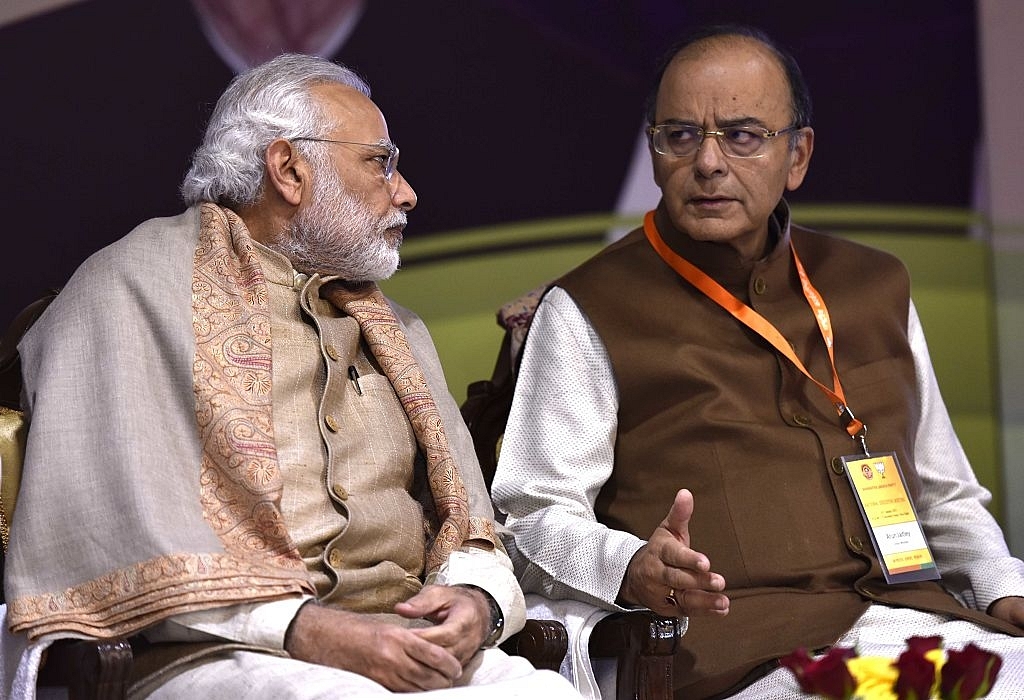Economy
PSU Disinvestment Will Be Enough To Fund Modi’s Ambitious Health, Farm Sector Agenda
- For those asking how Prime Minister Modi will pay for all the promises made in the budget, here is how disinvestment is likely to play out in the next fiscal.

Narendra Modi and Arun Jaitley (Virendra Singh Gosain/Hindustan Times via Getty Images)
The social sector spending outlay was the highlight of the budget presented by Finance Minister Arun Jaitley on 1 February. Health and farm sectors and rural infrastructure seem to be top-priority areas for the government in the election year. However, some big announcements such as a significant hike in the minimum support price (MSP) for crops and the promise of initiating the world’s biggest health insurance scheme have raised important concerns about funding. Where is the money to pay for such grand promises?
Contrary to popular perception, Modicare or National Health Protection Scheme (NHPS) isn’t an election gimmick devised days before the budget to win votes. According to a report in Firstpost, the scheme had been in the works for the last couple of years and the government has estimated that it would cost around Rs 10,000 crore with the states and the Centre funding it in a 60:40 ratio.
The hike in MSP is unlikely to cost more than the NHPS. There is also a substantial increase in allocations to rural infrastructure projects, the Ujjwala and Ujjala schemes. Where will this money come from?
The answer lies in the government’s success on disinvestment front this fiscal. Jaitley announced in his budget speech that he expected the proceeds from stake sale in public sector units (PSUs) to hit Rs 1 lakh crore against the target of Rs 72,000 crore set by him for fiscal year 2018. This is an admirable achievement given that not only was this highest ever collection by the Centre, it was only the fifth time in the last 27 years that the Union government had met its disinvestment target.
For fiscal year 2019, Jaitley has set a disinvestment target of Rs 80,000 crore. If the government aims high, it can certainly touch the Rs 1 lakh crore figure again. That additional collection alone will be enough to take care of most of the social sector spending push outlined in the budget.
But how realistic is the Rs 1 lakh crore target? It doesn’t appear impossible looking at what the government has in the pipeline for the next year. Most likely, Air India will be sold off in 2018-19 given the pace at which the central government is moving on this front.
Four state-run companies “including guided weapon systems maker Bharat Dynamics and engineering consultant Rites Ltd have filed preliminary applications in the past month for initial public offerings” which are likely to materialise in the next fiscal, claims this report in the Hindu Business Line.
According to Reuters, the government may be looking to sell stake in as many as 20 companies. It has already sought advisers to help it through this process. Secondary sale of 3 per cent stake in Indian Oil and 10 per cent stake in Coal India, and an IPO in Hindustan Aeronautics are also on the anvil. The government has already named banking advisers for these deals. Based on current share prices, the government may get around Rs 24,000 crore from stake sale in Indian Oil and Coal India alone.
The government took two general insurance companies public in 2017, and is planning to list another three in the coming months, at least one of which is likely to fetch monies in the next fiscal itself.
The government also owns private sector equity worth more than Rs 50,000 crore through its vehicle, SUUTI. In 2016-17, it divested equity of Rs 4,153.65 crore under ‘strategic disinvestment’. It is likely the government will keep tapping into this in future too.
What else? The government will be well-advised to cash out its LIC booty soon. If it doesn’t do so, it will be left with another GIC or New India Assurance, or, worse, an Air India or BSNL, with no LIC left to bail them out.
A big-bang listing of LIC in the first half of the next fiscal will fetch the government nothing less than Rs 50,000 crore in one shot for a share sale of up to 25 per cent, depending on market conditions. Waiting will mean losing a lot of the value. If the United Progressive Alliance had listed BSNL at the right time, it would have gotten three times as much money as it would do now. The National Democratic Alliance government shouldn’t repeat the mistake.
The government’s big success on disinvestment front this year shows that Rs 1-1.2 lakh crore target is very much within reach.
Introducing ElectionsHQ + 50 Ground Reports Project
The 2024 elections might seem easy to guess, but there are some important questions that shouldn't be missed.
Do freebies still sway voters? Do people prioritise infrastructure when voting? How will Punjab vote?
The answers to these questions provide great insights into where we, as a country, are headed in the years to come.
Swarajya is starting a project with an aim to do 50 solid ground stories and a smart commentary service on WhatsApp, a one-of-a-kind. We'd love your support during this election season.
Click below to contribute.
Latest